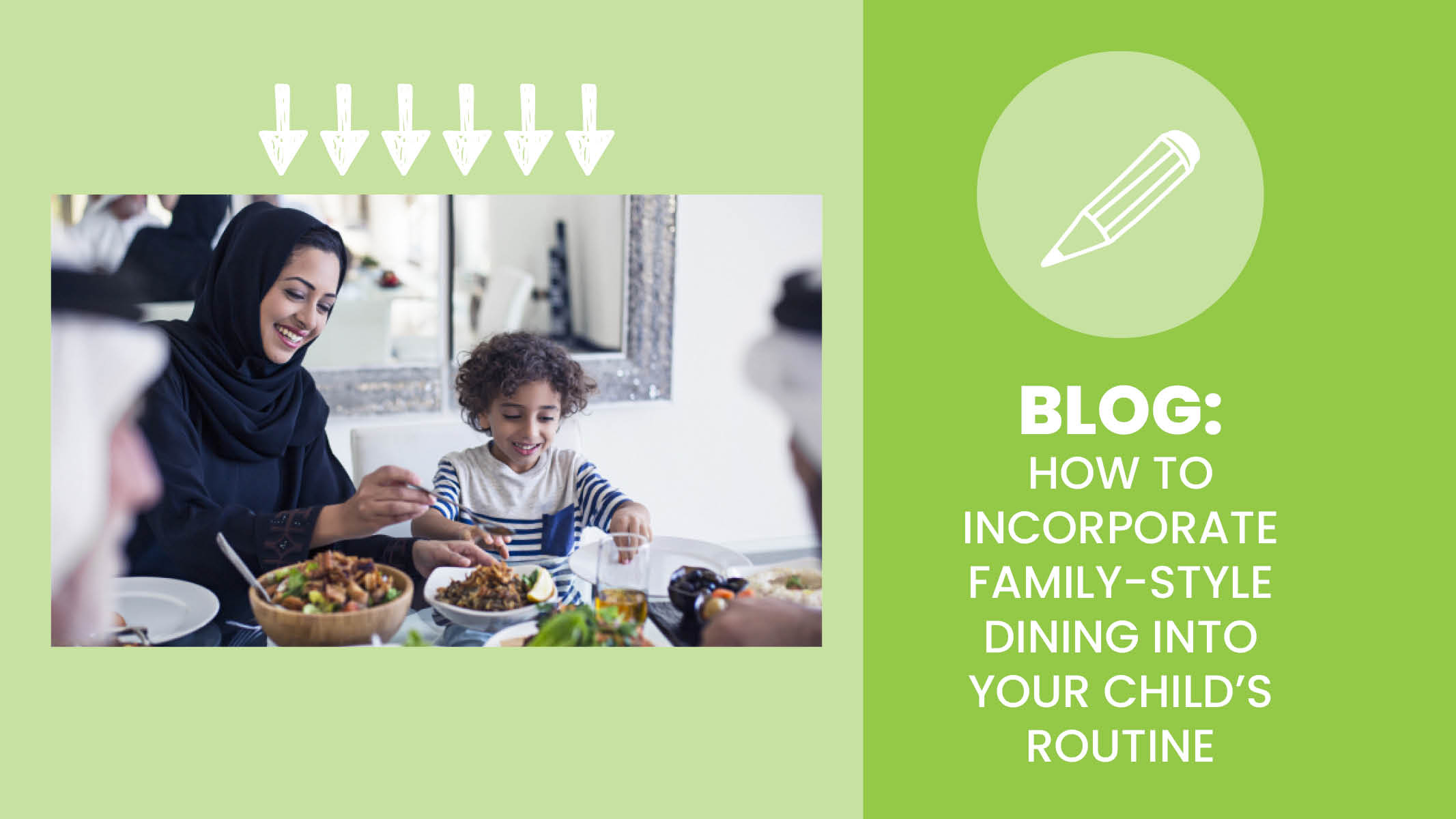Family-style dining is most seen in the home and childcare settings. What is it? Family-style dining is a method of dining where all the meal components are placed in large serving dishes and set on a table for those eating to serve themselves. Some common practices for family-style dining include:
- Shared responsibilities in meal preparations (i.e. cooking, setting the table, clearing plates after meals, etc.)
- These responsibilities should be based on age and capability.
- Sitting together at the table to eat as a group
- Everyone serving themselves (when possible)
This style of meal service has more benefits for kids than you might expect! Some benefits of family-style dining include:
- Skill development. By allowing children to use utensils and work on pouring, scooping, passing, and serving, they can increase their fine motor development and coordination skills.
- Building social skills. Giving children the opportunity to sit at the table to enjoy a meal with everyone and engage in conversation allows them to learn more about the people they spend time with and further develop their social skills, like sharing.
- Encouraging a healthy relationship with food and their hunger cues. Family-style dining allows children to choose what and how much goes on their plates. Not only does this allow for children to feel in control, it allows them to regulate their own portion sizes and recognize their feelings of hunger and fullness.
- Providing learning experiences. Having kids help with setting the table, preparing food, and cleaning up allows kids to feel a part of the process, creates a positive experience around mealtime, and gives them a chance to learn about everything that goes into creating a meal.
According to Annie Jacobson, a dietitian manager at Sanford Health, "Getting children involved is a great way to teach them about nutrition. When parents allow kids to be a part of grocery shopping and preparing meals, it helps them gain confidence and develop skills that teach the importance of healthy eating. Providing healthy options and teaching kids how to make healthy choices is key to ensure they have a healthy lifestyle in the future."
Why do caregivers like family-style meals? “Family-style dining allows kids of all ages to participate and learn from the meal experience. Younger kids will need guidance at the start but are sure to pick up on the process quickly by learning from older siblings' or caregivers' modeled behavior,” Annie says.
Family-style dining also provides an opportunity to connect with other kids and adults. If you’re interested in adding more connection to your mealtime, try one of these:
- Try solving a riddle at each mealtime
- Ask everyone to share the highlight of their day
- Talk about the health benefits of the food on your plate
- Explore new foods through senses like sight or touch
- Practice mindful eating. Have everyone at the table describe their food. Is it cold or hot? Crunchy or soft? Sweet or sour?
Ready to get started? Here are some tips to implement family-style dining in your environment:
- Start simple. Choose foods that are easier to serve for younger children. As they develop more skills, you can allow them to try serving more challenging foods.
- Pass and share. Pass the food around the table and encourage children to put some of everything on their plate. Try not to pressure or force them into trying something they’re intimidated by. This allows them the chance to be in control of their own foods. If you have picky eaters, check out this article to learn more about how you can engage your kids with new foods.
- How much is too much? Let children decide what and how much of the food they want to eat. You can provide guidance if children need help deciding the amounts. One way to help with serving sizes is to use child-size utensils and dishware. Younger children may need physical guidance (hand-over-hand serving) in the beginning as they continue to learn.
- Don’t give up. Family-style dining looks different for everyone. Explore what works best in your setting and recognize that it will take time for everyone to be comfortable with adopting a new dining style.
- Quick Tip: Start with incorporating one practice, like everyone helping to set the table, and continue adding practices and skills as the group learns and builds more skills.
If you’re out to eat in a restaurant setting, you can still implement family-style dining! Allow children to help decide on their meal from the menu and practice ordering the meal by themselves.
And don’t forget, patience is key. If family-style dining is a new thing for your family or group, it’s going to take time for your kids to get used to the process.
Ready for More? You Might Also Like:
Healthy Snacks Food Quiz
What Fruits and Vegetables Do for Your Body
Superfoods for Superpowers: How to Excite Your Kids for Green-Light Foods


